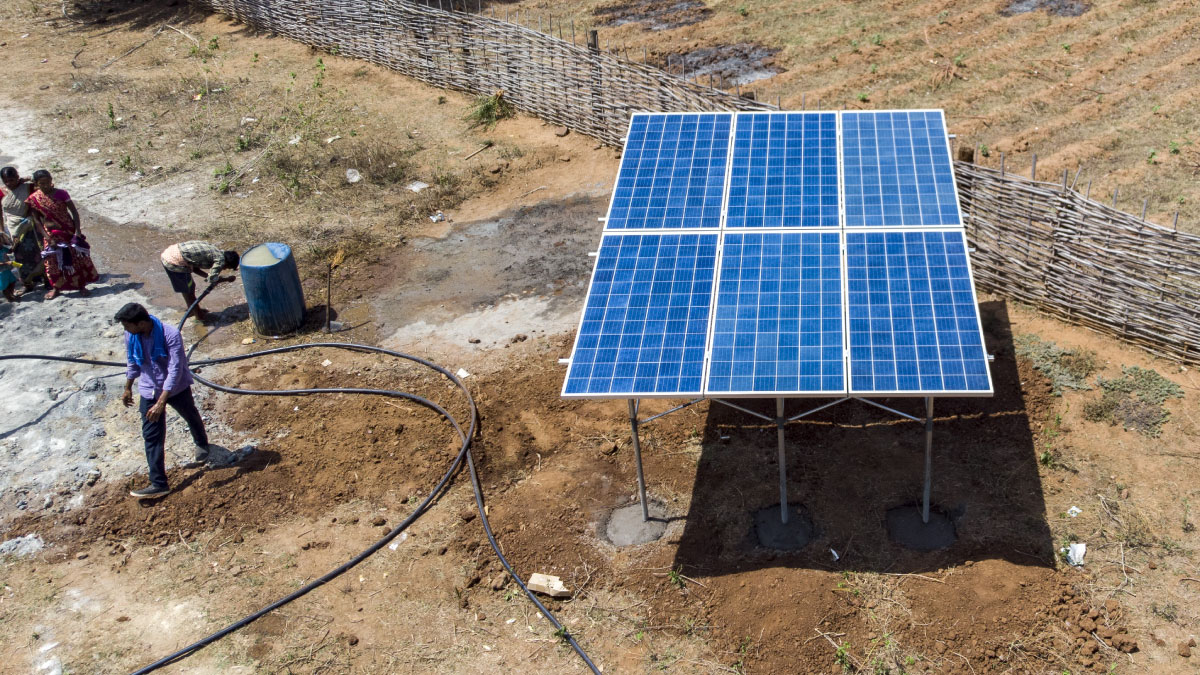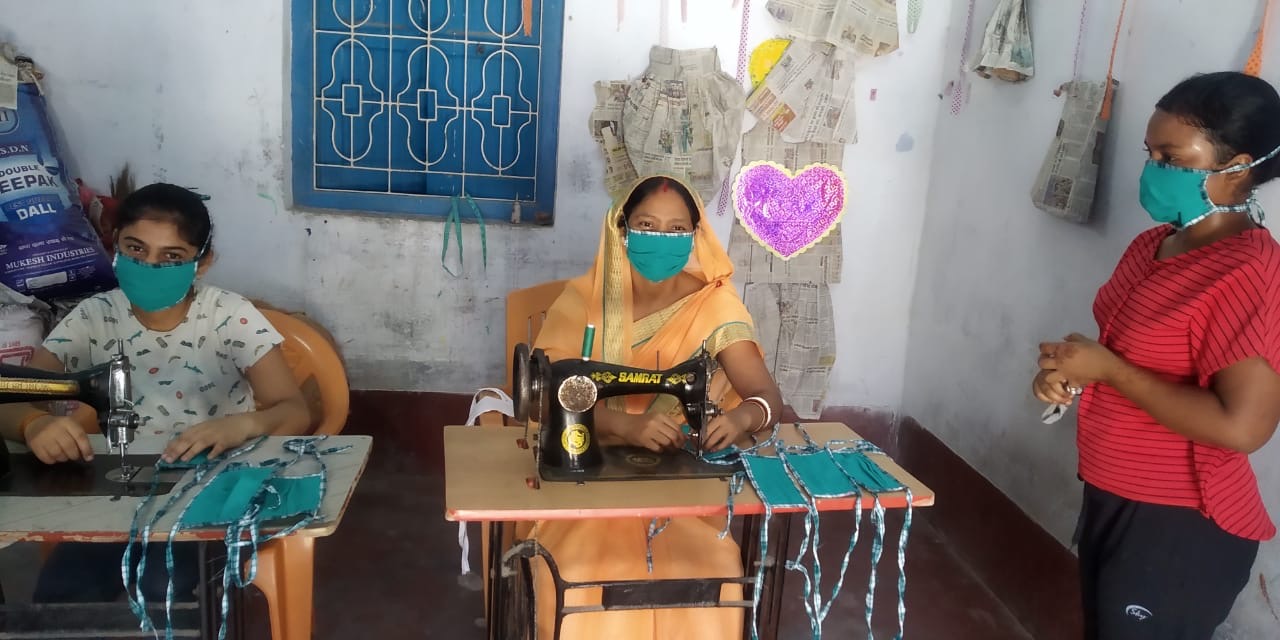Partnerships and sustainable business models can help scale up technologies needed to improve livelihoods in poor communities and achieve sustainable development goals.

© Prabuddha
A setting sun used to mean that Ruby Kumari had to close the doors to her home-made sewing school in Parsa, a village in the eastern Indian state of Bihar.
But the arrival of solar-powered minigrids in 2019 allowed her to stay open after sundown and offer additional classes, more than doubling enrolment to 80.
Access to affordable, reliable power also meant she could switch from manual to electric sewing machines, helping her transform her skills into a new business activity in 2020 when the COVID-19 pandemic put her teaching work on hold.
The 38-year-old became one of 25 seamstresses paid by Smart Power India under a plan to supply five face masks per household in various districts around Bihar, which shares a border with Nepal.
“It’s a comfort to have constant electricity when everything else is so unreliable,” she said.

Ruby Kumari. © Rockefeller Foundation
Ms. Kumari is just one of the thousands of entrepreneurs and business owners in rural India benefitting from the minigrids, made possible through a partnership between the Institute for Transformative Technologies (ITT), TATA Power and the Rockefeller Foundation.
The partnership, which aims to have 10,000 mini grids in place by 2026, was presented during an UNCTAD webinar on 27 April that explored solutions to the worrying trend that most new technologies remain out of reach for the poor.
The downside of technological revolutions
“The downside of technological revolutions is that the deployment phase tends to be uneven,” said Shamika N. Sirimanne, UNCTAD’s director of technology and logistics.
“Not everyone gets immediate access to the benefits of progress, such as access to electricity, life-saving vaccines or clean water.”
UNCTAD’s Technology and Innovation Report 2021 warns that uneven access can hamper technology’s contribution to the UN’s Sustainable Development Goals (SDGs) and worsen global inequalities, fuelling public discontent.
And with the advent of frontier technologies, including artificial intelligence (AI), robotics, biotechnology and nanotechnology, such risks have increased, according to the report.
Ensuring new technologies reach the poor
But partnerships like the one between Tata Power, ITT and the Rockefeller Foundation, can help reverse the trend and ensure new technologies, such as solar-powered electric grids, reach the poor communities that desperately need them.
According to Tata Power CEO Praveer Sinha, the minigrids partnership will help power over 100,000 Indian enterprises, deliver irrigation to 400,000 local farmers and improve access to health services and safe drinking water in rural communities.
With more than 40% of rural enterprises in states like Bihar relying on non-grid sources of power like diesel, the minigrids could save up to 1 million tons of carbon emissions annually.
Ms. Sirimanne said: “The partnership shows the impact that new technologies can have in developing countries when the local context isn’t ignored – and when they’re scaled up.”
“It also shows the need for a shift in thinking beyond mere profitability,” she added. “Inclusive and sustainable business models will be critical to deploying technologies that are bespoke for local contexts within developing countries.”
Multistakeholder partnerships needed
But while businesses and philanthropic organizations are key to scaling up technological solutions that address the needs of the poor, they can’t do it alone.
UNCTAD’s Technology and Innovation Report 2021 said governments must play a key role in influencing the trajectory of technology towards sustainable development causes.
Participants at the April webinar, who included researchers, civil society representatives and senior officials of governments and international organizations, said success requires a multistakeholder approach.
“A host of stakeholders including governments, entrepreneurs, academic and research institutions, civil society – makes up the essential ecosystem for the successful deployment of technology to communities,” said Alfred Watkins, chairman of the Global Solutions Summit, which co-organized the webinar with UNCTAD and ITT.
“But this ecosystem is largely technology agnostic and needs to be interconnected to formulate sustainable business models for equitable deployment,” he added.
Pilot projects for technology solutions that work well in one place often need to be adapted to work elsewhere, even in the same province, not to mention distant countries.
“If this does not happen, the result is a proliferation of pilot projects without long-term results,” Mr. Watkins said.
Between the piloting and scaling-up phases, a proven technology can get stuck, and might not reach the broader community.
Five principles when scaling up technology
To avoid overlaps and endless pilot phases of technology deployment, UNCTAD’s Technology and Innovation Report urges governments, enterprises and civil society organizations to adopt the following principles:
- Be guided by a vision: Organizations deploying technologies should start with an ambitious vision, such as “to provide drinking water to at least 100,000,000 people in the next five years.” This should include strategies for mobilizing the required resources – technical, financial, human capital, partnerships and others.
- Engage the users: Customers need to participate in both product development and product marketing phases because successful deployment programmes are a function of culture, values, ethics, trust, leadership, history, politics, as well as superstition, local customs and social structures.
- Plan for deployment: Deployment is an indispensable piece of the puzzle and requires at least as much attention as the quest for new discoveries.
- Pass the baton: Harnessing frontier technologies for the SDGs is like a relay race in which the baton must be passed quickly from the scientists and engineers who develop the solutions to innovators who will take the lead in deploying them at scale.
- Generate incomes: No matter how heavily technology is subsidized, people will not use it unless they can afford it. The solution is to prioritize technologies that also generate more income for households and communities – for example, by providing better access to formal markets, especially in rural areas.


